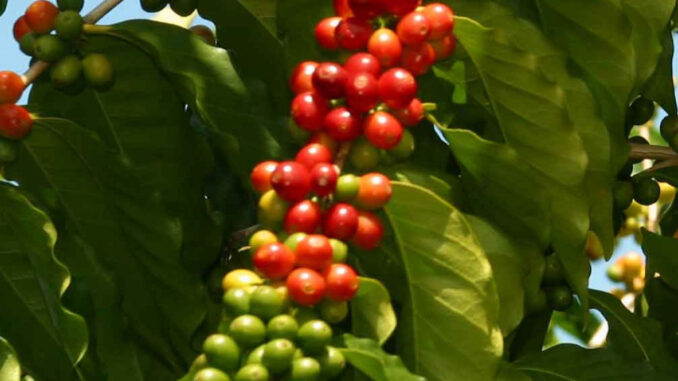
Among the world’s coffee species, Coffea liberica stands apart for its unusual flavor, giant beans, and remarkable hardiness.
Native to the tropical forests of West and Central Africa, this species is prized for its unique aroma, resistance to disease, and adaptability to harsh climates.
Although it represents less than 2% of global coffee production, Liberica is experiencing renewed interest as a potential key player in the future of sustainable coffee farming.
🌍 Origin and History
Coffea liberica was first discovered in Liberia, from which it takes its name.
It naturally grows in the rainforests of West and Central Africa, including Liberia, Uganda, and Angola.
In the late 19th century, a devastating coffee leaf rust epidemic destroyed vast Arabica plantations in Asia.
To save the industry, farmers introduced Liberica to the Philippines, Malaysia, and Indonesia, where it thrived due to its resistance and adaptability.
By the early 1900s, Liberica became a significant crop in Southeast Asia, especially in the Philippines, where it is known as Kapeng Barako — a symbol of Filipino coffee heritage.
🌿 Botanical Characteristics
The Liberica coffee tree is large and majestic, easily distinguished from Arabica and Robusta by its size and leaf shape.
Key features include:
- Tree height: Up to 15 meters tall (can be pruned to 3–5 m for cultivation)
- Leaves: Broad, dark green, and glossy
- Cherries: Large, oval, and thick-skinned
- Beans: Asymmetrical and almond-shaped — the largest of all coffee species
- Roots: Deep and strong, making the plant drought-resistant
Because of its robust physiology, Liberica thrives where Arabica struggles — in lowland, hot, and humid environments.
☕ Flavor Profile
The flavor of Liberica coffee is distinct and unlike any other.
It’s often described as bold, fruity, and aromatic, with a complexity that surprises many first-time drinkers.
Typical tasting notes:
- Heavy, syrupy body
- Low acidity
- Aromas of floral, woody, and smoky tones
- Hints of jackfruit, dark chocolate, and spice
- Sweet, lingering aftertaste
While Arabica is prized for its delicate balance, Liberica offers a wild and exotic character that appeals to adventurous coffee lovers.
🌱 Growing Conditions
Liberica is exceptionally tolerant to heat and humidity, making it suitable for tropical regions where Arabica cannot thrive.
Ideal conditions:
- Altitude: 200–800 meters
- Temperature: 22–30°C
- Rainfall: 1,500–2,500 mm annually
- Soil: Well-drained, slightly acidic tropical soils
Its deep roots allow it to survive droughts and poor soil quality, while its tough leaves resist fungal infections and pests.
🌾 Agricultural Advantages
✅ High resistance to pests and leaf rust
✅ Adaptable to low-altitude and hot climates
✅ Drought-tolerant due to deep root system
✅ Large, high-yielding cherries
✅ Low maintenance compared to Arabica
Because of these traits, Liberica is viewed as a potential solution for climate-resilient coffee farming in the tropics.
⚠️ Challenges in Cultivation
Despite its strengths, Liberica faces several challenges that limit its commercial spread:
❌ Tall trees make harvesting difficult
❌ Irregular fruiting patterns
❌ Thick fruit skin slows processing
❌ Distinct flavor not always suited to mainstream markets
❌ Limited infrastructure and knowledge for large-scale production
However, specialty roasters and researchers are now embracing Liberica for its diversity and genetic potential.
🧬 Sub-Varieties and Hybrids
Over time, Liberica has naturally diversified into several regional varieties and hybrids.
The most notable include:
1. Liberica var. Dewevrei (Excelsa)
- Discovered in Central Africa; also known as Excelsa coffee.
- Slightly smaller than typical Liberica but highly aromatic.
- Flavor: Fruity, spicy, and complex.
- Common in Vietnam, Indonesia, and the Philippines.
2. Liberica var. Dewevrei Barako (Kapeng Barako)
- Grown mainly in Batangas and Cavite, Philippines.
- Flavor: Strong, floral, and woody with notes of anise and dark chocolate.
- A symbol of Filipino coffee tradition.
3. Liberica var. robusta (Nganda or Koukou)
- Found in West and Central Africa.
- Despite the name, it is not related to Coffea canephora (Robusta).
- Flavor: Rich, earthy, and sweet.
- Highly resilient and suitable for lowland cultivation.
4. Malaysian and Indonesian Liberica
- Locally adapted versions of African Liberica introduced in the 19th century.
- Known for their fruity and caramel-like flavor.
- Increasingly popular in specialty markets for their exotic profiles.
☕ Modern Importance
In recent years, Liberica has reemerged as a key species for both coffee biodiversity and climate adaptation.
Its genetic diversity makes it valuable for crossbreeding programs aimed at developing disease-resistant and heat-tolerant hybrids.
Researchers are exploring Liberica–Arabica and Liberica–Robusta hybrids that could maintain cup quality while thriving under tropical stress conditions.
🌍 Regions Producing Liberica Today
Liberica is cultivated in small but growing quantities across:
- The Philippines 🇵🇭 (Barako)
- Malaysia 🇲🇾 (Johor, Selangor)
- Indonesia 🇮🇩 (Sumatra, Jambi)
- Liberia and Uganda 🌍 (wild populations)
- Sierra Leone and Congo 🌿 (heritage farms)
These regions highlight the species’ adaptability across continents and climates.
❤️ Final Thoughts
The Coffea liberica species is more than a botanical curiosity — it’s a symbol of coffee’s diversity and resilience.
With its unique flavor, large beans, and exceptional adaptability, Liberica bridges the past and future of coffee.
As climate pressures increase, this rare and powerful variety could become a cornerstone of sustainable, climate-smart coffee farming.
☕ Liberica coffee — bold, aromatic, and built for the future.
DeliciousPath: Enjoyment in Every Moment
Explore the Gourmet on Board category for exquisite flavors that elevate your meals, even when you’re on a boat, and the Coffee category for aromatic coffee blends that make every moment special. DeliciousPath is here to turn every experience into something unforgettable!




















